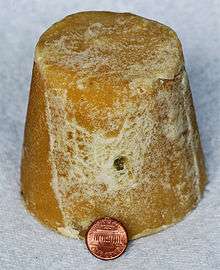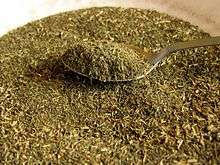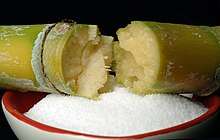List of unrefined sweeteners
This list of unrefined sweeteners includes all natural, unrefined, or low-processed sweeteners.
Sweeteners are usually made from the fruit or sap of plants, but can also be made from any other part of the plant, or all of it. Some sweeteners are made from starch, with the use of enzymes. Sweeteners made by animals, especially insects, are put in their own section as they can come from more than one part of plants.
From sap


The sap of some species is concentrated to make sweeteners, usually through drying or boiling.
- Cane juice, syrup, molasses, and raw sugar, which has many regional and commercial names including demerara, jaggery, muscovado, panela, piloncillo, turbinado sugar, and Sucanat, are all made from sugarcane (Saccharum spp.).
- Sweet sorghum syrup is made from the sugary juice extracted from the stalks of Sorghum spp., especially S. bicolor.
- Mexican or maize sugar can be made by boiling down the juice of green maize stalks.[1]
- Agave nectar is made from the sap of Agave spp., including tequila agave (Agave tequilana).[2]
- Birch syrup is made from the sap of birch trees (Betula spp.).[3]
- Maple syrup, taffy and sugar are made from the sap of tapped maple trees (Acer spp.).[4]
- Palm sugar is made by tapping the flower stalk of various Palm trees to collect the sap. The most important species for this is the Indian date palm (Phoenix sylvestris), but other species used include palmyra (Borassus flabelliformis), coconut (Cocos nucifera), toddy (Caryota urens), gomuti (Arenga saccharifera), and nipa (Nypa fruticans) palms.[5][6]
- The sweet resin of the sugar pine (Pinus lambertiana) was considered by John Muir to be better than maple sugar.[7]
- A sugary extract from manna ash that contains the sugar mannose and the sugar alcohol mannitol.
From roots
The juice extracted from the tuberous roots of certain plants is, much like sap, concentrated to make sweeteners, usually through drying or boiling.
- Sugar beet syrup (Zuckerrübensirup in German) is made from the tuberous roots of the sugar beet (Beta vulgaris).[8] Sugar beet molasses, a by-product of the processing to make refined sugar, also exists but is mainly used for animal feed.[9]
- Yacón syrup is made from the tuberous roots of yacón (Smallanthus sonchifolius ).[10]
- Sweet Cicely root
- Licorice root
From nectar and flowers
- A "palatable" brown sugar can be made by boiling down the dew from flowers of the common milkweed (Asclepias syriaca).[7]
- The nectar of mahua can be used to make a syrup.
From seeds
The starchy seeds of certain plants are transformed into sweeteners by using the enzymes formed during germination or from bacterian cultures. Some sweeteners made with starch are quite refined and made by degrading purified starch with enzymes, such as corn syrup.
- Barley malt syrup is made from germinated barley grains.[11]
- Brown rice malt syrup is made from rice grains cooked and then cultured with malt enzymes.[12]
- Amazake is made from rice fermented with Koji (Aspergillus oryzae).[12]
From fruits
Many fresh fruits, dried fruits and fruit juices are used as sweeteners. Some examples are:
- Watermelon sugar, made by boiling the juice of ripe watermelons.[13]
- Pumpkin sugar, made by grating the pumpkins, in the same manner as to make beet sugar.[14][15]
- Dates, date paste, spread, syrup ("dibs"), or powder (date sugar) are made from the fruit of the date palm (Phoenix dactylifera).
- Jallab is made by combining dates, grape molasses and rose water.
- Pekmez is made of grapes, fig (Ficus carica) and mulberry (Morus spp.) juices, condensed by boiling with coagulant agents.
A variety of molasses are made with fruit:
- Carob molasses is made from the pulp of the carob tree's fruit.[16]
From leaves

In a few species of plants the leaves are sweet and can be used as sweeteners.
- Stevia spp. can be used whole, or dried and powdered to sweeten food or drink. Uniquely, stevia contains no carbohydrates or calories.[17]
- Jiaogulan (Gynostemma pentaphyllum), has sweet leaves, although not as sweet as Stevia.[18]
- Hydrangea macrophylla Has sweet leaves that are used to make a sweet tea called amacha
By animals
- True honey, made by honey bees (Apis spp.) from gathered nectar.
- Sugarbag, the honey of stingless bees, which is more liquid than the honey from honey bees.[19]
See also
- Australian Aboriginal sweet foods
- Natural brown sugar (some brown sugars are refined)
- List of food additives
- Sugar substitute
- Molasses
References
- Johnston, James F. W.; Arthur H. Church (1880) [1880]. The Chemistry of Common Life. D. Appleton and company. p. 198. Retrieved 2008-06-01.
The Chemistry of Common Life James F. Johnston.
- Beckley, Jacqueline H.; Jack Huang; Elizabeth Topp; Michele Foley; Witoon Prinyawiwatkul (2007). Accelerating New Food Product Design and Development. Blackwell Publishing. p. 36. ISBN 978-0-8138-0809-3. Retrieved 2008-05-13.
- Kallio, Heikki; Tuija Teerinen; Seija Ahtonen; Meri Suihko; Reino R. Linko (1989). "Composition and Properties of Birch Syrup (Betula pubescens)" (PDF). J. Agric. Food Chem. 37: 51–54. doi:10.1021/jf00085a012. Retrieved 2008-05-14.
- Moerman, Daniel E. (1998). Native American Ethnobotany. Timber Press. pp. 38–41. ISBN 978-0-88192-453-4. Retrieved 2008-05-14.
- Balfour, Edward (2007-05-29) [1871]. Cyclopædia of India and of Eastern and Southern Asia, Commercial, Industrial and Scientific. 1 (2nd ed.). Oxford University. p. 194. Retrieved 2008-05-15.
- Lock, Charles George Warnford; George William Wigner; Robert Henry Harl (2007-10-22) [1882]. Sugar Growing and Refining. E. & F. N. Spon. pp. 408–409. Retrieved 2008-05-15.
- Saunders, Charles Francis (1976). Edible and Useful Wild Plants of the United States and Canada. Courier Dover Publications. p. 219. ISBN 978-0-486-23310-9.
- Emery, Carla (2003). The Encyclopedia of Country Living, An Old Fashioned Recipe Book. Sasquatch Books. p. 313. ISBN 978-1-57061-377-7. Retrieved 2008-05-13.
- Draycott, Philip A. (2006). Sugar Beet. Blackwell Publishing. p. 451. ISBN 978-1-4051-1911-5. Retrieved 2008-05-13.
- Manrique, I.; A. Párraga; M. Hermann (2005). "Yacon syrup: Principles and processing" (PDF). Series: Conservación y Uso de la Biodiversidad de Raíces y Tubérculos Andinos: Una Década de Investigación Para el Desarrollo (1993-2003). 8B: 31p. Retrieved 2008-04-27.
- Roehl, Evelyn (1996). Whole Food Facts: The Complete Reference Guide. Inner Traditions / Bear & Company. pp. 134–135. ISBN 978-0-89281-635-4.
- Belleme, John; Jan Belleme (2007). Japanese Foods That Heal. Tuttle Publishing. pp. 55–58. ISBN 978-0-8048-3594-7. Retrieved 2008-05-13.
- California Legislature (1868). The Journal: 22nd. Sess., 1878. App. F.P. Thompson, Supt. state printing. p. 470. Retrieved 2008-06-02.
watermelon sugar -Richard -Brautigan -In Watermelon Sugar.
- Hovey, M. C. (1841) [1841]. The Magazine of Horticulture, Botany, and All Useful Discoveries. Hovey and Co. p. 32. Retrieved 2008-06-03.
pumpkin sugar.
- The Magazine of Science, and Schools of Art. D. Francis. 1841 [1841]. p. 192. Retrieved 2008-06-03.
pumpkin sugar.
- Basan, Ghillie; Jonathan Basan (2007). The Middle Eastern Kitchen. Hippocrene Books. p. 158. ISBN 978-0-7818-1190-3.
- Kinghorn, A. Douglas (2002). Stevia: The Genus Stevia. CRC Press. ISBN 978-0-415-26830-1.
- "Gynostemma pentaphyllum". Plants For A Future. Retrieved 2008-04-29. External link in
|work=(help) - Menzel, Peter; Faith D'Aluisio (1998). Man Eating Bugs: The Art and Science of Eating Insects. Ten Speed Press. p. 29. ISBN 978-1-58008-022-4. Retrieved 2008-06-02.
man eating insects.
External links

